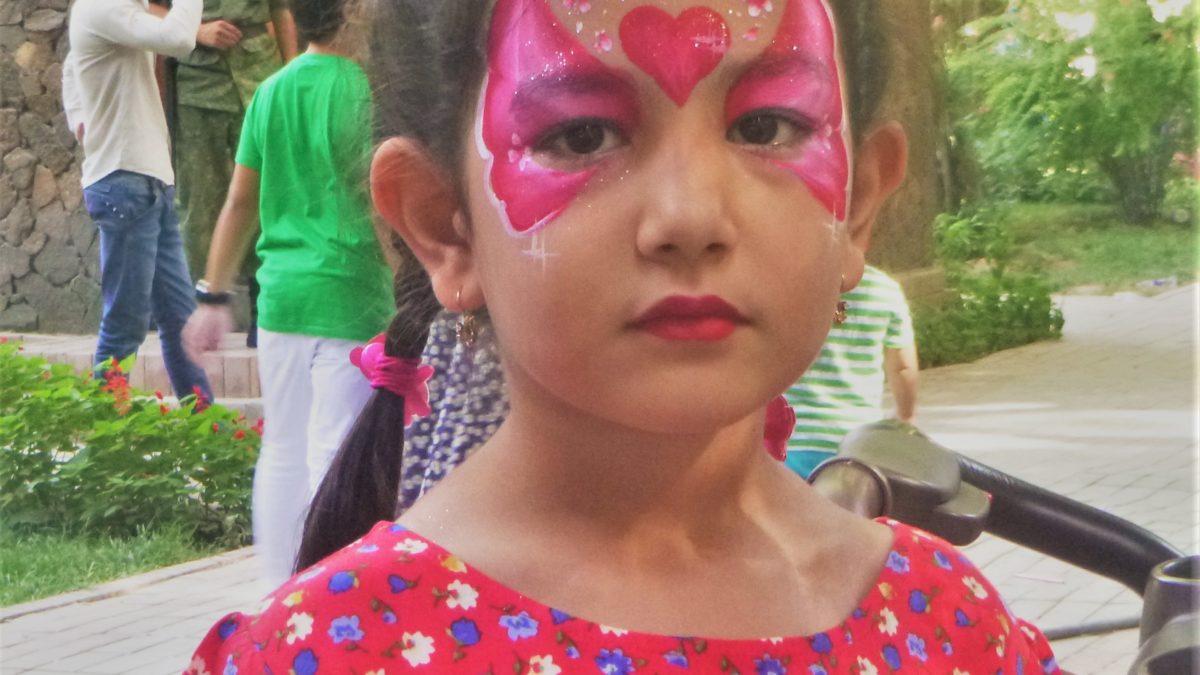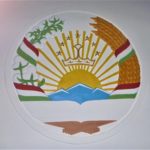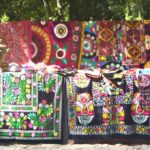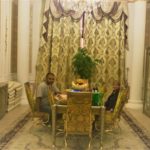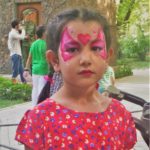Journey to Tajikistan, and the Connections…
Judit, the Jewish Warrior Queen of Ancient Ethiopia
November 5, 2019
The Best WWII Refuge for Jews in Occupied Europe Was…Albania??
January 3, 2020Journey to Tajikistan, and the Connections…
With UNO, No Frills, and Access Bank (2014)
By Rich Juro
During our recent visit to the remote nation of Tajikistan, Fran and I experienced more warm hospitality than we’ve had in any other of the 160 countries we’ve been to, and it was due to the “University of Nebraska-Omaha connection”. Here’s the story:
We had journeyed through the four “stans” of Central Asia (Kazakhstan, Kyrgyzstan, Uzbekistan, and Turkmenistan) with a group in 2013, but there was no visit to Tajikistan. The tour company felt that the Tajik political troubles might result in injury or harm to someone in the group. But Fran and I were determined to get to this small country located just north of Afghanistan and southwest of China. So we set up our own trip.
It was difficult to locate a guide in Dushanbe on the Internet. Instead we contacted Komron R., a Tajik native who studied at UNO and works at Creighton University. We also talked to Vickie Stone, an administrator of International Studies at UNO, and assistant to Dean Tom Goutierre. Vickie and Komron put us in touch with friends and former students who are now back in Tajikistan.
First Day in Dushanbe
Leaving London at 10:30 AM, with stops in Istanbul and Almaty, Kazakhstan, we arrived quite tired 24 hours later on Astana Airline in Dushanbe. Sure enough, Komron’s friend Sadi was at the small airport to pick us up. We walked outside to the vehicle: a brand new Lexus SUV, which costs about $150,000 in Tajikistan. Commenting that the Lexus was his brother’s, he dropped us off at the Serena Hotel and promised to come over later.
After unpacking and lunch at the hotel, we waited for Sadi. Sure enough, he showed up, although a half hour late, in his own car: a Bentley convertible! Although very expensive, it had a badly cracked windshield and bad brakes. Sadi complained he couldn’t get anything fixed locally. Fran complained that she couldn’t get into or out of this car.
Forget Sadi’s luxury vehicles. Tajikistan is the poorest former Soviet republic. There is high unemployment, and 80% of Tajiks are younger than 35. With 93% of the country consisting of very high mountains, there are few natural resources and limited agriculture. The only important exports are electricity (from its hydroelectric dams) and workers. Two million of the nation’s eight million citizens take jobs in Russia or other countries. The national languages are Tajik and Russian, but now many young people learn English. Dushanbe is expanding as people move from the mountain villages seeking better-paying occupations.
Dushanbe has about 800,000 people, and, with more coming every day, there are building projects everywhere. That’s a good thing, as Sadi’s brother has a large construction company. Sadi proudly showed us his own project, a 10-story multi-use structure, to be finished soon.
We embarked on a city tour and went past the two Dushanbe landmarks: one was the tallest flagpole in the world (take that, Dubai); the second was the large statue of Ismail Somoni, the emir who introduced Islam and, 1200 years ago, expanded the small Tajik state into the large Samanid Empire. With its capital at the famous city of Bukhara, in what is now Uzbekistan, the empire covered a large portion of Central Asia, including big chunks of nearby Iran, Afghanistan, and Turkmenistan.
80 years after Emir Somoni died, the area was overrun by Turkic tribes, and the Tajik nation disappeared for nine centuries until the Soviet Union set it up again as an autonomous republic in 1924. However, Stalin placed the ancient capitals of Bukhara and Samarkand in Uzbekistan, to the consternation of the thousands of Tajiks living there. When the Soviet Union dissolved, an independent Tajikistan was established in 1991. The old statue of Lenin was taken down, and the 33 meter high sculpture of Somoni erected, complete with a heavy gold crown. However, a nasty civil war erupted, and political unrest continued until recently.
Emomalii Rahmon has been President of Tajikistan since 1994, and it looks like he will continue in that office for the foreseeable future. There are eight political parties, and democratic Parliamentary elections are held, but President Rahmon makes the important decisions.
Mt. Somoni, the highest peak in Tajikistan, indeed in the whole former USSR, also was named for Ismail Somoni by the Soviets. (Before 1991, it was called Stalin Peak.) Tajik currency is called the Somoni, appropriately pronounced sow-money. I brought back some for a young friend who collects foreign currency. (Of course, her Dad is a banker.)
Next we set off toward Varzob Gorge, the #1 sight in the area. But first Sadi said, “I’m sorry, I have to make a couple of business stops.” Each one involved a half-hour discussion while Fran and I waited in the car. More interesting to us were the two times when Sadi was pulled over to the curb by a local policeman. Each cop was then given a couple of U.S. dollars. We couldn’t determine whether we were stopped because of the Bentley, the driving speed, or maybe it was just “business as usual”. (Cops aren’t paid many Somonis, so they have to supplement their income.)
We finally arrived at Varzob Gorge, and enjoyed a lovely drive alongside the natural canyon formed by the Varzob River as it flows from the mountains toward Dushanbe. There are many wooden houses and villas along the riverside, and locals obviously enjoy partying and swimming on the weekends. There’s plenty of alcohol drunk although this is a predominantly Muslim nation.
In chatting with Sadi on the ride back, we discovered a surprising coincidence: although he lived in Omaha for 3 years, Sadi never did enroll at UNO, but he did work as a dairy clerk for us at No Frills Supermarket on Saddle Creek Drive. Living on 72nd Street, he would walk or use his friend Ilhom’s bike to get to the store 2-3 miles away, even on icy, snowy days. Eventually, Sadi’s brother, who had sent him to Omaha, told him to come home.
Day 2: The Festival
The next morning we took a taxi over to Trip Adviser’s #2 rated attraction in Dushanbe, the Noor Art Gallery. However, we were disappointed to find that it was just a shop in the Hyatt Hotel with a nice selection of Tajik arts and crafts.
Fran had told Sadi that it was very hard for her to get in and out of his Bentley sports car, so instead his (and Komron’s) friend Ilhom picked us up. Ilhom is a big friendly guy who loves to wear Husker Football or Nebraska T-shirts. He told us: “I would have loved to play football but I didn’t have the time when I was in college in Omaha.” I think he would have been good, too, although UNO has now dropped football. With Ilhom were his lovely wife and their two adorable kids.
We drove on the main street, Rudaki Avenue, named for a blind Persian poet who lived 1200 years ago. You have to love a city whose principal boulevard is named for an ancient poet. We arrived at the large park, the Dushanbe Botanical Garden, located right behind the Chinese Embassy. The average summer daytime temperature in Dushanbe is about 95 degrees, but it’s a dry heat, so by staying in the shade of the big trees it was actually comfortable.
This was the Tajik marriage season. There were many young couples attired in suits and brocaded bridal dresses for wedding pictures. The photos were taken at a large outdoor chapel lined with boughs and garlands of purple flowers. More pictures were taken under a large tree, with an optimistic sign pinned to it in Tajik and English: “Tree of Happiness”.
An annual festival was taking place. We strolled by a large number of outdoor vendors selling food, drinks, rugs, clothing, toys, crafts, and other items. Fran said it was the best place for shopping, and bought a few T-shirts and knick-knacks. We arrived at the main attraction: a large stage on which appeared a succession of singers, dancers, and musicians. Hundreds of young people were in front of the stage singing and dancing Tajik and Western songs along with the performers. What a treat to hear “Yellow Submarine” sung with a Tajik accent and accompanied by a Central Asian musical stringed instrument! The featured singer finally appeared; surprisingly, he was from Pakistan. Ilhom’s 6 year-old, Maryam, waited in the long line for face painting, and came back looking like a beautifully colored butterfly. It was really fun to see how everyone, young and old, enjoyed the day.
Ilhom had a lovely family. His wife was Tajik but had been with him in the USA. After graduating from UNO, Ilhom got a master’s degree in accounting at the University of Missouri – Kansas City. That’s where Maryam was born, so she can choose American citizenship when she turns 18. Ilhom is a very well qualified professional, having also passed the CPA exam before they went back to Tajikistan. He is an auditor for IRS, but not the IRS you’re thinking of. Instead, his IRS is the company that runs the toll road near Dushanbe. And, yes, his e-mail address ends in “@irs.tj”, with “tj” short for Tajikistan.
The main challenge for Ilhom and his wife is that their son, Abdul Aziz, was born with what we call “brittle bone disease”. So the sweet, smiling, 2 ½ year old boy looks in size about half his age, and has just begun to “scoot” a little bit, not yet crawling. Ironically, Children’s Hospital in Omaha is well-equipped to treat this problem. However, living in Tajikistan, the best they can do is flying with Abdul Aziz three times a year to a Moscow medical facility, a long and expensive trip. The family has also been able to get a German non-profit group to supply some of the needed drugs to Dushanbe. Abdul Aziz is making a little progress, but it’s not a good long-term solution. Ilhom is looking into immigrating to Canada with his family, mainly for the needed medical care. (Update: Ilhom and his family did emigrate to Toronto, Canada, and Abdul Aziz is doing much better with proper medical care.)
At the festival, we met up with two business interns from Stanford University who are working in Dushanbe. One was from Indiana, the other from Moscow. Both spoke perfect English, though the Russian didn’t have a twang. They were both enjoying their time in Tajikistan, but I think Konstantin, being from Russia, better understood the convoluted way business works in a former Soviet republic…but that’s another story.
There were a couple of people handing out flyers from “Access Bank” describing the 10% annual interest paid in US dollars on deposits in the bank. I took a brochure to show my banker (the father of the girl who collects foreign currency) that he should be more competitive or I’d move my savings to Tajikistan.
Dinner at Sadi’s…and the local Police Station
Sadi insisted that we have dinner at his place. So Ilhom picked us up and drove us to the five-story building that was Sadi’s family home. It was built by his brother and housed Sadi and his wife on the top floor; his brother’s family on the second floor; and his parents on the ground floor. Sadi’s father had four wives, which is not unusual for a wealthy Muslim man. The father himself was retired and spent most of his days in a small town in the countryside where he had built a mosque. I don’t know if one or all of the wives lived in the Dushanbe house, in the small town, or elsewhere. (I have trouble just keeping track of one wife.) The rest of the Sadi’s family had gone to a cousin’s family event that evening.
Although the building was 5 years old, the elevator had never been finished. So we trudged up 4 flights of stairs to a very large and ornate dining room. Sadi’s servant brought in enough food – fruits, vegetables, salad, soup, mutton, chicken, and desserts – to feed a dozen people even though we were only four. Tajik hospitality knows no bounds!
As we were leaving, Ilhom received a phone call from Harrison, the American intern we had met in the park. The two interns had gone somewhere after the festival, were stopped by the local cops, and found to be living at a different address than was listed on their visas. This is a no-no for visitors to Tajikistan. So instead of our hotel, Ilhom and Sadi brought us to the police station. Fran and I sat in the car in the dark for about an hour waiting for our hosts to reappear. Finally they did, looking pleased. The local gendarmes were apparently looking for a substantial bribe, but instead Sadi had called a higher-up official, who got the situation resolved, or at least that’s the version we got. (Frankly, this incident was much less exciting than others where Fran herself has gotten into trouble with local authorities in Uganda, Ethiopia, and North Korea.)
Day 3: Museum and Dinner
We had read mixed reviews of the National Museum, so we were pleasantly surprised to discover a large three story modern air-conditioned building with signs in Tajik, Russian, AND English. The admission was 25 somonis ($5 U.S.) plus $6 for a knowledgeable English speaking guide. Two floors covered the natural and political history of the Tajik lands from prehistoric times until the present. The third floor was local artwork and crafts, mostly paintings from the Soviet era. The treasure of the museum is a 50 foot reclining Buddha. Overall, we were astonished at the quality of the museum in this country with very little tourism infrastructure.
By e-mail, we had invited the other UNO grads to dinner at a restaurant of their choice. Ahror picked us up and drove us to Amon Jon, a local eatery in the Russian area (or maybe it was a Russian restaurant in the Amon area?). I asked Ahror why it seemed like everyone drove cars rather than bikes or motorbikes, even though Tajikistan was reputedly a very poor country. His answer: “Most of the cars are stolen and smuggled in so they are not very expensive.”
At Amon Jon we met three other UNO alums, Amvar, Aziz, and Alisher, and we were joined by their friend, Akmalkhon, who had studied in California. (Do most male names in Tajikistan begin with “A”?) A couple of them were married, but it seems to be a Tajik custom not to bring wives to dinner. They ordered a variety of local foods, which were all delicious. We had a stimulating discussion about UNO, Nebraska, the USA, Tajikistan, Russia, world affairs, politics, etc. They expressed affection for Vickie Stone, the UNO international studies administrator, who was their advisor and friend. I asked for the check but found that the guys had already paid. It would be a violation of Tajik hospitality to let a guest pay for anything.
At 3 AM the next morning we were getting ready to leave when Sadi called. He sleepily asked if we needed a ride to the airport, a final example of Tajik hospitality. We thanked him and said we were taking a taxi.
Conclusion
Our visit to Tajikistan was short but memorable. Our journeys are usually interesting, especially to less visited countries like this one. But this trip was unique because we were embraced by the locals who felt an obligation to show us the all-inclusive hospitality that defines Tajik culture.
While we had been afraid at our age to experience the Pamir Highway that snakes its way through the high mountain passes of Tajikistan, hopefully we can return when it is paved and the bandits are gone. In the meantime, we will keep fond memories of our experiences and the people in the wonderful place that is Tajikistan.
Final note: when we returned to Omaha, I attended a Rotary luncheon sponsored by, yes, Access Bank. I asked the Access banker if I could get 10% interest at the local branch. He said “No”.

